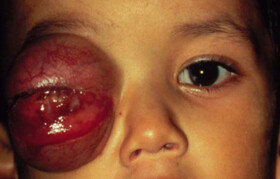
Retinoblastoma is a rare, cancerous tumor of a part of the eye called the retina.
Causes, incidence, and risk factors
Retinoblastoma is caused by a mutation in a gene controlling cell division, causing cells to grow out of control and become cancerous.
In a little over half of the cases, this mutation develops in a child whose family has never had eye cancer.
Other times the mutation is present in several family members. If the mutation runs in the family, there is a 50% chance that an affected person’s children will also have the mutation. They will therefore have a high risk of developing retinoblastoma themselves.
The cancer generally affects children under the age of 6. It is most commonly diagnosed in children aged 1 – 2 years.
Symptoms
One or both eyes may be affected.
They pupil may appear white or have white spots. A white glow in the eye is often seen in photographs taken with a flash. Instead of the typical “red eye” from the flash, the pupil may appear white or distorted.
Other symptoms can include:
- Crossed eyes
- Double vision
- Eyes that do not align
- Eye pain and redness
- Poor vision
- Differing iris colors in each eye
If the cancer has spread, bone pain and other symptoms may occur.
Signs and tests
The following tests may be advised by the doctor:
- Eye exam with dilation of the pupil
- Ultrasound of the eye (head and eye echoencephalogram)
- CT scan or MRI of the head
- Bone marrow biopsy and cerebrospinal fluid examination in the case of more aggressive tumors
Treatment
Treatment options depend on the size and location of the tumor.
- Small tumors may be treated by laser surgery or cryotherapy.
- Radiation is used for both local tumor and for larger tumors.
- Chemotherapy may be needed if the tumor has spread beyond the eye.
The eye may need to be removed (a procedure called enucleation) if the tumor does not respond to other treatments. In some cases, it may be the first treatment.
Expectations (prognosis)
If the cancer has not spread beyond the eye, almost all patients can be cured. A cure, however, may require aggressive treatment and even removal of the eye in order to be successful.
If the cancer has spread beyond the eye, the likelihood of a cure is lower and depends on how the tumor has spread.
Complications
Blindness can occur in the affected eye. The tumor can spread to the eye socket through the optic nerve. It may also spread to the brain, lungs, and bones.
Prevention
Genetic counseling can help families understand the risk of retinoblastoma. It is especially important when more than one family member has had the disease, or if the retinoblastoma occurs in both eyes.
